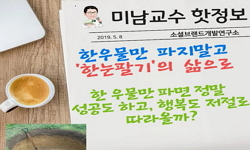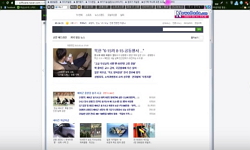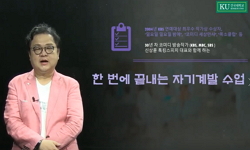This article is aimed to examine the patterns of remorse feelings in <Manbunga>, a work by Jo, Wie. This work embodies the writer's sorrow from the long-term banishment for the false accusation in 'Muosawha' and desperate mind with pain in the s...
http://chineseinput.net/에서 pinyin(병음)방식으로 중국어를 변환할 수 있습니다.
변환된 중국어를 복사하여 사용하시면 됩니다.
- 中文 을 입력하시려면 zhongwen을 입력하시고 space를누르시면됩니다.
- 北京 을 입력하시려면 beijing을 입력하시고 space를 누르시면 됩니다.
https://www.riss.kr/link?id=T11947952
- 저자
-
발행사항
진주 : 경상대학교 대학원, 2010
-
학위논문사항
학위논문(석사) -- 경상대학교 대학원 , 국어국문학과 고전 문학 , 2010. 2
-
발행연도
2010
-
작성언어
한국어
- 주제어
-
발행국(도시)
경상남도
-
형태사항
iii, 59 p. ; 26 cm
-
일반주기명
지도교수: 최용수
- 소장기관
-
0
상세조회 -
0
다운로드
부가정보
다국어 초록 (Multilingual Abstract)
This article is aimed to examine the patterns of remorse feelings in <Manbunga>, a work by Jo, Wie. This work embodies the writer's sorrow from the long-term banishment for the false accusation in 'Muosawha' and desperate mind with pain in the site, expressing the remorse feeling of the banished person.
Maegye Jo, Wie (1454~1503), a scholar in King Seongjong of Joseon Dynasty, entered government service at age of 21 and went through smooth career as a beloved retainer for his poems and writings by King Seongjong successfully filling a wide range of internal/external government posts over 25 years. However, in the fourth year of King Yeonsangun's reign, he was falsely accused of an accidental 'writing affair' to be banished and finish his life in the banished site without returning to home for a long time. This historical background is critical in understanding his <Manbunga>. Thus, his writing of this work is closely related to the time. To summarize the discussed contents of this article to understand the ating process and characteristics of his <Manbunga> is as follows. Chapter I describes the purpose of this article, reviews research history and examines the political and social environment at that time that drove him to write this work as well as his life as the background of the work. Chapter II reviews the composition and expressive methods for this work to identify the characteristics of his work. A banishment song <Manbunga> is composed of 3 phases as the common poetic songs; introduction, main body and conclusive part. The expressive methods used in this work include symbolic representation and analogy.
Chapter Ⅲ investigate the causes of remorse feeling to identify the changing patterns of the remorse feelings in <Manbunga>, the subject of this article, and examined the variously expressed remorse emotions in the work. The causes of remorse feeling can be attributed to the bitter resentment from his lengthy banishment status due to false accusation in 'Muosawha'. The changing patterns of the remorse feelings include the remorse feeling from resentment by false accusation, remorse feeling from frustration at returning to politics for the next and remorse feeling from resignation. At first, the remorse feeling is expressed strongly but eventually weakened in consecutive fashion. This chapter examined the social and psychological effect that can be gained by expressing the remorse feeling. The remorse feeling begins with the rage from becoming a banished person for false accusation. By expressing the deep remorse feeling through <Manbunga>, the writer was psychologically relieved by himself and tried to deliver his regret of being unable to get free from the banishment to the King and the society.
Chapter Ⅳ demonstrates the significance of this work in literary history in that the writer revealed his remorse feeling secretively using literary techniques and various materials in expressing his pains and humanistic agony from the banishment.
While chapter Ⅴ suggests a possibility of new interpretation beyond previous discussions of this work as a King-loving poetic song by demonstrating that this work is a literature of remorse feeling, it does not reach psychological understanding of the writer in forming the narrator's remorse feeling in the work. This limitation shall be the task to solve in the future research.
국문 초록 (Abstract)
유배가사는 조선조에 당쟁으로 인해 정치권력에서 폐출된 양반 사대부들이 지은 문학으로 당시 일반 사대부의 문학과는 다른 독특한 특징을 지니고 있다. 이러한 배경에서 창작된 가사는 ...
유배가사는 조선조에 당쟁으로 인해 정치권력에서 폐출된 양반 사대부들이 지은 문학으로 당시 일반 사대부의 문학과는 다른 독특한 특징을 지니고 있다. 이러한 배경에서 창작된 가사는 당쟁이나 사화로 희생된 작가들이 지은 작품이라 현실적으로 내면을 직접적으로 표현하기가 어려웠다. 그런 까닭으로 그들은 자신의 심정을 우회하거나 암시적으로 드러낼 뿐 표면적으로는 유교 이념이 담긴 충정심을 강조하여 심회를 표출하게 된다. 그런데 작품 속에는 충정의 의미만 들어 있는 것이 아니라 그 이면에는 한의 의미를 내포하고 있다.
<萬憤歌>는 님에 대한 지극한 충정과 작가의 한을 동시에 드러내고 있다. 이 글에서는 <萬憤歌>를 한의 문학으로 보고 작품에 녹아 있는 정서가 한을 바탕으로 하고 있으므로 의미를 재해석하고자 하였다.
먼저 제Ⅱ장에서는 <萬憤歌>의 창작배경과 작품의 특성을 살펴보는데, 작가의 생애와 정치·사회적 배경을 중심으로 살펴보았다. 조위는 어려서부터 문재가 뛰어났으므로 성종의 명으로 『杜詩諺解』의 찬집에 동참하는 영애를 얻기도 하였다. 그러나 후일 ‘무오사화’에 연좌되니 그 글재주로 인하여 유배 길에 들어서게 되는 불운을 겪게 되었으므로 <萬憤歌>라는 가사를 남기고 생을 마감하게 되었다. 그리고 작품의 특성으로는 구성과 표현기법을 살펴보았는데, 구성에 있어서는 <萬憤歌>도 일반 가사의 구성에 따라 서사·본사·결사 3개 단락으로 나누어져 있다. 작품은 통한의 정서가 집중적으로 응축되어 있어 그 요소들을 10개 단락으로 나누어서 살펴보았다. 또한 표현기법으로 상징과 비유, 대구법을 통해서 화자가 자신의 내재된 한의 정서를 표출하는데 직설적으로 드러내지 않고 자신의 심회의 한을 효과적으로 드러내기 위해 암시적 방식을 취하고 있었다.
제Ⅲ장에서는 이 글의 주제인 <萬憤歌>에 나타난 한의 양상을 본격적으로 다루었다. 먼저 작품 속에 나타나게 된 한의 발생 원인을 알아보고, 한의 변화 양상을 집중적으로 파악하여 작가의 한 표출의 심리적·사회적 효과를 살펴보았다. <萬憤歌>의 작가에 있어서 한은 ‘무오사화’에 연좌되어 유배된 것이지만, 처음 유배지에서 끝나지 않고 순천으로의 이배됨으로 원분이 응어리져 있었던 것이라 생각되었다. 또한 기약 없는 유배로 인하여 조상에 성묘하지 못하는 불효함도 한의 원인으로 작용되었을 것이다. 이와 같이 한의 정서는 변화 양상을 보이고 있는데, 무고에 의한 원분→정계복귀 좌절의 한→절망에 의한 체념 등 처음에는 강하다가 점차적으로 약하게 순차적으로 드러내고 있었다. 한 표출에 있어서 화자는 자신의 잘못이 아님에도 오랜 유배생활에서 감당할 수 없는 심리적 압박감과 극심한 정서적 불안에 시달리면서 절망감이나 갈등의 심정을 문학이라는 통로를 이용하여 <萬憤歌>속에 드러냈다고 할 수 있다. 그 결과 작품에 나타난 작가의 한은 무고죄로 유배된 분노로 인해 원분의 아픔을 해소하지 못하고 가슴에 응축되어 있던 고통의 흔적이 작품 속에 그대로 반영되어 나타나고 있었다.
제Ⅳ장에서는 <萬憤歌>를 한이 담긴 문학으로 보고 문학사적 의의를 살펴보았다. 이 작품이 한의 문학으로서 가치는 양반 사대부가 원분이 쌓여서 한이 된 감정(憾情)을 적나라하게 표출하지 않고, 다양한 소재를 활용하여 서정적으로 묘사하여 한을 은밀하게 드러낸 것에서 오묘한 경지를 얻어낸 것이라 할 수 있다.
이 글은 기존의 논의와는 달리 <萬憤歌>를 한의 문학으로 보고, 한의 정서를 밝히는데 목적을 두었다. 하지만 이 작품을 한의 문학으로써 중요성을 밝히기 위해 다각도로 노력하였으나 한을 형성시킨 심리파악에는 미치지 못하였다. 이는 <萬憤歌>에 대한 기존의 연구가 유교 이념인 충절의식을 우위에 두고 원분을 토로하는 관점에서 논의되었고 한의 문학으로 접근하여 논의된 것이 거의 없기 때문이다. 그리하여 <萬憤歌>에 나타난 ‘한의 양상’에서 다루지 못한 한을 형성시킨 심리 파악에서 미진한 부분은 후대 연구자들의 폭넓은 관심을 기대 하면서 과제로 남겨 두고자 한다.
목차 (Table of Contents)
- Ⅰ. 머리말 1
- 1. 연구 목적과 방법 1
- 2. 연구사 검토 4
- Ⅱ. 창작 배경과 작품의 특성 9
- 1. 창작 배경 9
- Ⅰ. 머리말 1
- 1. 연구 목적과 방법 1
- 2. 연구사 검토 4
- Ⅱ. 창작 배경과 작품의 특성 9
- 1. 창작 배경 9
- 2. 작품의 특성 24
- Ⅲ <萬憤歌>에 나타난 恨의 양상과 표출 효과 33
- 1. 恨의 발생원인 33
- 2. 작품에 표출된 恨의 변화 양상 37
- 1) 무고에 의한 원분의 한 38
- 2) 정계복귀 좌절의 한 41
- 3) 체념의 한 44
- 3. 恨 표출의 심리적 사회적 효과 48
- 1) 심리적 효과 48
- 2) 사회적 효과 50
- Ⅳ. <萬憤歌>의 문학사적 의의 54
- Ⅴ. 맺음말 58
- [참고문헌] 60












